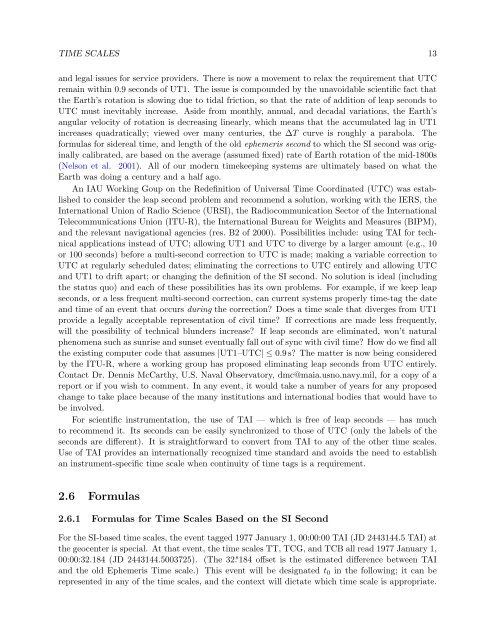USNO Circular 179 - U.S. Naval Observatory
USNO Circular 179 - U.S. Naval Observatory
USNO Circular 179 - U.S. Naval Observatory
Create successful ePaper yourself
Turn your PDF publications into a flip-book with our unique Google optimized e-Paper software.
TIME SCALES 13<br />
and legal issues for service providers. There is now a movement to relax the requirement that UTC<br />
remain within 0.9 seconds of UT1. The issue is compounded by the unavoidable scientific fact that<br />
the Earth’s rotation is slowing due to tidal friction, so that the rate of addition of leap seconds to<br />
UTC must inevitably increase. Aside from monthly, annual, and decadal variations, the Earth’s<br />
angular velocity of rotation is decreasing linearly, which means that the accumulated lag in UT1<br />
increases quadratically; viewed over many centuries, the ∆T curve is roughly a parabola. The<br />
formulas for sidereal time, and length of the old ephemeris second to which the SI second was originally<br />
calibrated, are based on the average (assumed fixed) rate of Earth rotation of the mid-1800s<br />
(Nelson et al. 2001). All of our modern timekeeping systems are ultimately based on what the<br />
Earth was doing a century and a half ago.<br />
An IAU Working Goup on the Redefinition of Universal Time Coordinated (UTC) was established<br />
to consider the leap second problem and recommend a solution, working with the IERS, the<br />
International Union of Radio Science (URSI), the Radiocommunication Sector of the International<br />
Telecommunications Union (ITU-R), the International Bureau for Weights and Measures (BIPM),<br />
and the relevant navigational agencies (res. B2 of 2000). Possibilities include: using TAI for technical<br />
applications instead of UTC; allowing UT1 and UTC to diverge by a larger amount (e.g., 10<br />
or 100 seconds) before a multi-second correction to UTC is made; making a variable correction to<br />
UTC at regularly scheduled dates; eliminating the corrections to UTC entirely and allowing UTC<br />
and UT1 to drift apart; or changing the definition of the SI second. No solution is ideal (including<br />
the status quo) and each of these possibilities has its own problems. For example, if we keep leap<br />
seconds, or a less frequent multi-second correction, can current systems properly time-tag the date<br />
and time of an event that occurs during the correction? Does a time scale that diverges from UT1<br />
provide a legally acceptable representation of civil time? If corrections are made less frequently,<br />
will the possibility of technical blunders increase? If leap seconds are eliminated, won’t natural<br />
phenomena such as sunrise and sunset eventually fall out of sync with civil time? How do we find all<br />
the existing computer code that assumes |UT1–UTC| ≤ 0.9 s? The matter is now being considered<br />
by the ITU-R, where a working group has proposed eliminating leap seconds from UTC entirely.<br />
Contact Dr. Dennis McCarthy, U.S. <strong>Naval</strong> <strong>Observatory</strong>, dmc@maia.usno.navy.mil, for a copy of a<br />
report or if you wish to comment. In any event, it would take a number of years for any proposed<br />
change to take place because of the many institutions and international bodies that would have to<br />
be involved.<br />
For scientific instrumentation, the use of TAI — which is free of leap seconds — has much<br />
to recommend it. Its seconds can be easily synchronized to those of UTC (only the labels of the<br />
seconds are different). It is straightforward to convert from TAI to any of the other time scales.<br />
Use of TAI provides an internationally recognized time standard and avoids the need to establish<br />
an instrument-specific time scale when continuity of time tags is a requirement.<br />
2.6 Formulas<br />
2.6.1 Formulas for Time Scales Based on the SI Second<br />
For the SI-based time scales, the event tagged 1977 January 1, 00:00:00 TAI (JD 2443144.5 TAI) at<br />
the geocenter is special. At that event, the time scales TT, TCG, and TCB all read 1977 January 1,<br />
00:00:32.184 (JD 2443144.5003725). (The 32. s 184 offset is the estimated difference between TAI<br />
and the old Ephemeris Time scale.) This event will be designated t0 in the following; it can be<br />
represented in any of the time scales, and the context will dictate which time scale is appropriate.


